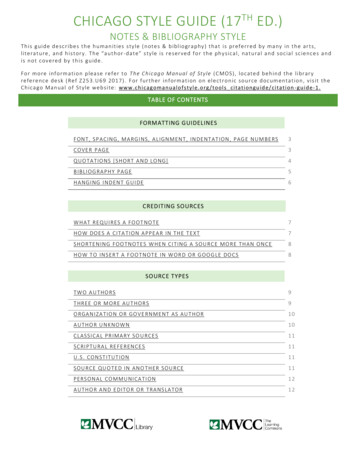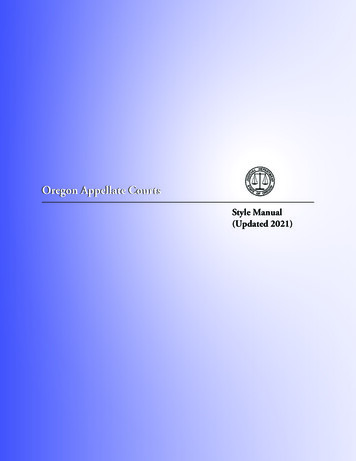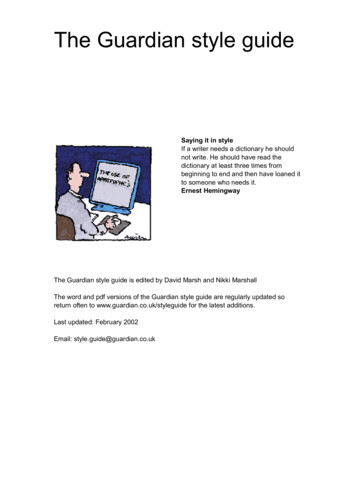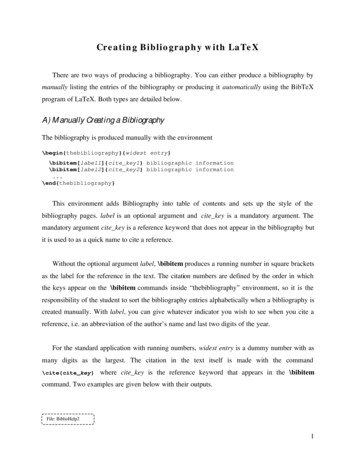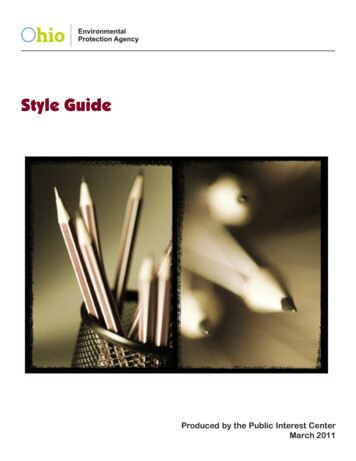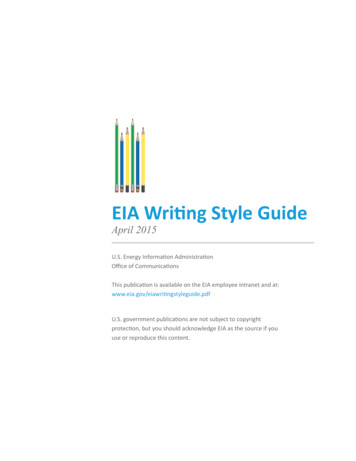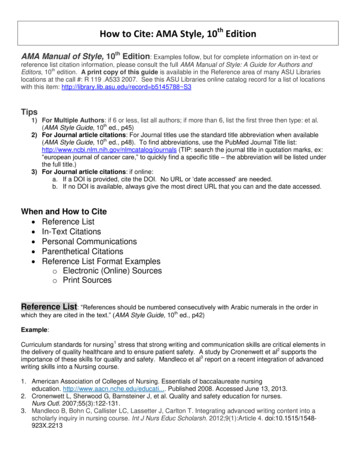
Transcription
STYLE MANUALFourth EditionPrepared under the Direction of the AIP Publication BoardSearchable version provided with permission byKen Hanson; home page http://public.lanl.gov/kmh/American institute of PhysicsNew Y o r k
Copyright @ 1990 American lnstitute of Physics, Inc.This book, or parts thereof, may not be reproducedin any form without permission.Library of Congress Catalog Card Number 89-81194InternationalStandard Book Number 0-88318-642-XAmerican lnstitute of Physics500 Sunnyside Blvd.Woodbury, NY I1797AIP Pub. R-283.2Printed in the United States of AmericaFirst edition, 1951Second edition, 1959; revisions 1963,1965,1967,1968,1969,1970,1973Third edition, 1978Fourth edition, 1990fifth printing, 1997
PrefaceThe American Institute of Physics published its firstStyle Manual in 195 1. It was produced at the request of thePublication Board, which was made up of the editors of allMember Society journals, and with their approval.At that time there were five Member Societies, eachpublishing one or two journals through the services providedby the Institute. Now there are ten Member Societies, whichbetween them publish about forty archival journals and seven translated journals. In addition, AIP itself now has a publishing program that comprises seven archival journals,eighteen translated journals, and two magazines.Roughly half of the Member Society journals are stillproduced through AIP's publishing services, as are all ofAIP's own publications. But the remainder are published bytheir Member Society owners independently of AIP's copyediting and composition facilities.The 1951 AIP Style Manual was followed by a secondedition in 1959 and a third edition in 1978. This year, in thefourth edition, the emphasis is changing. The Style Manualis no longer tied closely to the procedures followed in theAIP journal production offices, but instead attempts to accommodate the different style rules and procedures practiced throughout the AIP "family" of journals. It presentsadvice which, if followed, should result in the preparation ofclear, concise, and well organized manuscripts eminentlysuitable for submission to any physics or astronomy journaleditor's office.At the time of the third edition ( 1978 ) the text pages ofmany AIP and Member Society journals were composed bytypewriter, because the monotype composition used earlierhad become too expensive. Since then practically all journalpages have been produced by computer-controlled photocomposition, and at the present time a second generation ofcomputer typesetting systems is coming into use. The nextsteps, which will be made possible by this new typesettingtechnology, will include the easy transfer of authors' owndigitized text files to the publisher's composition systemwithout rekeyboarding, and, eventually, the production ofcomplete "electronic pages" that can be stored on disks ortransmitted by telephone line.Given the accelerating march of new publishing technology, it appears probable that the next edition of the AIPStyle Manual will have to follow this one at a closer intervalthan has been the case with the previous editions.The number of members of the AIP staff and of thePublication Board, both past and present, to whom the Institute is indebted for their various contributions to this Manual is so great that it would take another section to namethem all. Instead, therefore, a hearty "Thank you" to all ofyou from today's AIP and Publication Board.Robert T. BeyerChair, AIP Publication Board
I. Summary information for journal contributorsA. MANUSCRIPT PREPARATIONThe information on this and the following page is a summary of the advice given in detail in later sections of themanual. Authors should note in addition that the journal forwhich they are writing may have particular requirementsthat differ in detail from those presented here. Consult the"Information for Contributors" page in the selected journal.In general, a study of the form and style of published articlesis the best guide to the requirements of individual journals.1. General instructionsManuscripts must be in English (American usage andspelling), typed or printed double spaced throughout, onwhite paper preferably 2 15 X 280 mm ( 84 x 11 in. ) in size.Use one side of the page only, leaving wide margins at bothsides and at top and bottom. Indent paragraphs. Number allpages consecutively, beginning with the title and abstractpage. Submit the original manuscript with production-quality figures and one or more duplicate copies (including clearcopies of figures), as required by the editor of the journal towhich the manuscript is submitted. Manuscripts that cannotbe read or easily understood will be returned to the author.Include the following material, in the order shown:a. title, with the first word capitalized,b. authors' names,c. authors' affiliations, including adequate postaladdresses,d. abstract, preferably on the first page with the title,e. appropriate indexing codes selected from thePhysics and Astronomy Classification Scheme(see Appendix I ) ,f. text,g. acknowledgments,h. appendixes (if necessary ) ,i. collected references in the order in which theyare cited,j. tables, each with a caption,k. collected figure captions,1. figures,m. if necessary, supplementary material for deposit inAIP's Physics Auxiliary Publication Service(see Appendix J).Ask someone else to read the manuscript, however satisfied you may be with its clarity and accuracy. A second pairof eyes can often find a typographical error or unclear statement that the author missed.2. AbstractAn abstract must accompany every article. It should bea concise summary of the significant items in the paper, including the results and conclusions. In combination with thetitle it must be an adequate indicator of the content of thearticle, because it will appear separated from the text andillustrations in electronic bibliographic databases and print-ed abstracting journals. For this reason the abstract shouldnot contain literature citations that refer to the main list ofreferences attached to the complete article, nor allusions tothe illustrations. Define all nonstandard symbols and abbreviations. Do not include tabular material or illustrations ofany kind. Avoid "built-up" equations that cannot be rendered in linear fashion within the running text. Type or printthe abstract double spaced, preferably as a single paragraph.It should be about 5% of the length of the article, but notmore than about 500 words.3. MathematicsType or print as much of the mathematical material aspossible. Handwritten material must be neatly lettered inblack ink. When confusion is possible, distinguish betweensimilar-looking letters, numbers, and special symbols whenthey first occur [for example, the number "one" ( 1) and theletter "ell" (1); the Roman letter "kay" ( k ) and the Greekletter "kappa" ( K ) ; the "proportional to" symbol ( a ) andand so on]. Write the identificationthe Greek "alpha" (a),of these symbols in the margin where they first occur.Notation should be clear, as simple as possible, and consistent with standard usage. Display all numbered equationson separate lines set off from the text above and below. Consecutive numbering of equations throughout the text is generally preferred, in which case use arabic numbers in parentheses flush right with the right margin. In some journals,numbering by section may be permitted, with the sectionnumber made part of the equation number.4. Footnotes and referencesType or print all footnotes (including references) in order of citation as a separate double-spaced list at the end ofthe manuscript, before the tables and figures. Start with footnotes to the title, authors' names, and authors' affiliations;for these, some journals use a sequence of letter superscripts,some use a series of symbolic indices (asterisks, daggers,etc.). Check a recent issue of the journal to which the paperis to be submitted for the correct form. Acknowledgments offinancial support should be made in the acknowledgmentssection of the paper, not as footnotes to the title or to anauthor's name. For literature references in the body of thepaper, most AIP and Member Society journals prefer tonumber them in order of appearance and list them in thatorder at the end of the article. (Some journals will also permit references to be cited in text by author and year only,with the reference list arranged alphabetically by author'sname; see See. I1 C 10 for a more complete discussion.) Inthe usual case, where literature citations are numbered, usesuperscript arabic numerals appearing in consecutive numerical order through the text. The names of authors in thereference list should be given in the form in which they appear on the title page of the cited work, with the family name("surname") last. For journal references use the standardabbreviations for journal names given in Appendix G; givethe volume number, the first page number, and the year ofpublication. For model footnotes and references see Table 11.
5. TablesTabular material more than four or five lines longshould be removed from running text and presented as aseparate table. Type each table double spaced on a separatepage after the list of footnotes and before the collected figurecaptions. Use roman or arabic numerals, according to theusage in the selected journal. Be sure to cite every table in thetext. Each table must have a caption that is complete andintelligible by itself without references to the text. Columnheadings should be clear and concise, with appropriate units.Type or print a double horizontal line below the caption, asingle line below the column headings, and another doubleline at the end of the table. For footnotes to a table use thesequence of letters a, b, c, etc., with a new sequence for eachtable. Place the footnotes themselves below the double line atthe end of the table. For a model table, see Table 111.6. Figures and figure captionsNumber figures with arabic numerals in order of appearance in the text; be sure to cite every figure in the text.Give every figure a caption, complete and intelligible in itselfwithout reference to the text. Type or print the list of captions double spaced on a separate page or pages at the end ofthe manuscript. Place the figures themselves in sequenceafter the collected captions. Write the figure number andauthors' names at the bottom of each figure; if it is necessaryto write on the back of a photograph, write very lightly witha soft pencil. Indicate the orientation required if it is notobvious from the content.To protect figures against damage in transit, make themno larger than 215 x 280 mm (84 x 11 in.); mail them flat,well protected by stiff cardboard. In general, figures shouldbe planned for reduction to the journal column width. Linedrawings are best made with India ink on Bristol board,thick smooth paper, or high-quality tracing cloth. Use whitematerial only, with lines solid and black. Draw symbols andletters so that the smallest ones will be not less than 1.5 mm(1/16 in.) tall after reduction; the largest lettering shouldnot be out of proportion. Avoid gross disparities in the thicknesses of lines and in the sizes of symbols and letters. Do nothandletter; use a stencil or other mechanical device instead.Submit original line drawings or high-quality glossy photographic prints.Increasing use is being made of computer-controlledplotters in the preparation of line drawings. While these devices can make excellent drawings for reproduction, theyoften produce lines that are too fine and data points that aretoo small to survive reduction. Lettering produced by theplotter must meet the same standards as those on conventionally drawn illustrations. Photographs should be printedin high contrast on glossy paper. Most journals can publishcolored illustrations when the color is an important featureof the scientific content; contact the editor to determine anyspecial requirements of the specific journal.7. Physics Auxiliary Publication ServiceMaterial that is part of and supplementary to a paper,but of too limited interest to warrant full publication in thejournal, should be prepared for deposit in AIP's PhysicsAuxiliary Publication Service and submitted with the paper.Examples are copious data tables, detailed spectrum plots,and code for computer programs. See Appendix J.B. PROCEDURES AND CORRESPONDENCE1. Correspondence before acceptanceSubmit manuscripts directly to the journal editor. Specify in the covering letter which author and address, if thereare several, is to be used in correspondence.All manuscripts submitted to journals published by AIPor its Member Societies are subject to anonymous peer review. The editor chooses the referees and makes the finaldecision to accept or reject the paper. Most manuscripts arereturned to their authors for revisions recommended by theeditor and referees. Thus it will typically take some monthsfor a paper to be finally accepted. Accompanying the noticeof acceptance may be a form which, when signed by theauthor, transfers the copyright of the written work to thejournal owner (AIP or Member Society). The Transfer ofCopyright Form should be properly completed and signed;in most journals your paper cannot be published without it.There may also be a Publication Charge form on which theauthor (or a representative of the author's institution) certifies whether or not the publication charge will be honored,and a form for ordering copies of reprints.2. Correspondence after acceptanceAfter a paper has been accepted, send correspondenceabout all editorial matters to the office indicated in the noticeof acceptance. In all correspondence, reference must bemade to the journal name (several journals may be producedin the same publishing office), the title of the paper, theauthors (emphasizing first author's last name), and thescheduled date of publication.3. ProofsFor those journals typeset by AIP, proofs are sent fromthe Composition area directly to the author, and should bereturned promptly, after correction, to the Managing Editorof the journal in question. Extensive changes from the original are costly and may delay publication while being reviewed by the editor. Authors may be charged for the expense of making extensive changes in proof.
II. Preparing a scientific paper for publicationA. WRITING THE PAPER2. General rules for writingNo two scientific papers are sufficiently alike that anytidv grouo of fixed rules for writing a scientific oaoer couldapply to all papers with inevitabc success. It is possible,however, to state principles and offer suggestions that willencourage any author to present a body ofscientific information in a reasonablv smooth and coherent form. We oresentthe following guidelines in this spirit and with a consciouseffort to help the novice.The following rules can be applied with profit to all technical writing and to all parts of a scientific paper. For specificsee Set.points( 1 ) Be clear. Consider the beauty and efficiency of thesimple declarative sentence as a medium for communicatingscientific information. Use it freely, but not exclusively.Avoid long, meandering sentences in which the meaningmay be obscured by complicated or unclear construction.( 2 ) Be concise. Avoid vague and inexact usage. Be asquantitative as the subject matter permits. Avoid idle words;make every word count.( 3 ) Be complete. Do not assume that your reader has allthe background information that you have on your subjectmatter. Make sure your argument is complete, logical, andcontinuous. Use commonly understood terms instead of local or highly specialized jargon. Define all nonstandard symbols and abbreviations when you introduce them. On theother hand, omit information unnecessary for a completeunderstanding of your message.( 4 ) Put yourself constantly in the place of your reader.Be rigorously self-critical as you review your first drafts, andask yourself "Is there any way in which this passage could bem i s u n e r s t o oby someone reading it for the first time?"d".1111. Before beginning to writeDespite the natural tendency to feel that no work is being done on a paper if no actual writing is under way, adequate preparation can help ensure a logical, readable product and shorten the writing time. Preparation can followthese steps.( 1 ) Analyze the problem. Ask yourself at least thesefour questions:( a ) Exactly what information do I wish to present inthis paper?( b ) For what specific group of readers am I writing?( c ) What background information can I assume thesereaders have?( d ) What is the most logical sequence in which I shouldpresent the information to the readers?( 2 ) Make a detailed outline. The outline will serve asyour writing guide; therefore, make as many subdivisions aspossible. It is easier to eliminate or combine existing subheadings than to insert new ones. As you write, you will,almost certainly, revise the outline. Even if the outlinesuffers drastic revision before the paper is finished, the veryact of preparing and modifying it serves as a mental stimulusthat goes far toward ensuring logical development of thesubject matter. Be sure your outline reflects the true structure and emphasis you wish your paper to have. Rememberthat many hurried readers will scan the headings and subheadings to determine if they need to read the entire text; tryto help them by making the headings informative and logical.( 3 ) Plan tables and figures. You may already havethought about the tables and figures while preparing the outline, but if not, do it at this stage. Some data lend themselvesto presentation in tabular form; others do not. Appropriatefigures can be very valuable, but there are times when a fewgood sentences convey more information than a drawing orphotograph. Avoid unnecessarily duplicating data in tablesand figures. Select the form of presentation-tables, figures,or text-with the efficient presentation of your data as theonly criterion.( 4 ) Sit and think. This step should precede, follow, andbe interspersed with the others. In other words, do not try torush through the entire process in one continuous effort, butcontinually stop and review what you have done and thinkagain about what is to come.3. English as a common language( 1 ) Scientists whose native language is English are fortunate that so much of the world's scientific literature is inEnglish, and that so many members of the internationalscience community have accommodated so well to this fact.Nevertheless, they should be aware that their papers will beread by those to whom English is a foreign language. Complex sentence structure and regional idiomatic usages willtend to obscure the meaning. Although AIP journals employAmerican spelling and usage, some American idioms (suchas "ball-park figure," to cite an extreme example) are notuniversally understood. "International English" may becolorless by literary standards, but it is understandable bythe largest number of readers.( 2 ) Those whose native language is not English need tobe particularly careful to make sure their manuscripts areclearly and grammatically written before submission.Whenever possible, ask someone who is a native Englishspeaker, and who has at least some knowledge of your subject matter, to read the manuscript in draft form and comment on the writing style. Having a good knowledge of thetechnical terminology and being able to read written Englishdoes not guarantee the ability to write accurate English. Theproper use of definite and indefinite articles, and the properchoice of prepositions, are notorious examples of Englishwriting style that non-English speakers find difficult. Nonnative English speakers may not even be aware, solely fromtheir experience as readers of well-written English texts, ofthe nuances they need to observe when they turn to writingEnglish themselves. Editors and referees will, in general,
make every effort to judge the scientific content of a paperwithout being negatively influenced by poor English style,provided the errors are not bad enough to obscure the meaning. In extreme cases, however, papers must be returned totheir authors for rewriting by a native English speaker beforethey can be reviewed.4. The introductionEvery scientific paper should have at least one or twointroductory paragraphs; whet her this introduction shouldbe a separately labeled section depends upon the length ofthe paper. Paradoxically, although it appears first it shouldbe written last. You will probably find it easier to start writing the introductory text after you have written part or all ofthe main body of the paper; in this way, the overall structureand content are more easily seen.The first sentence of the paper is often the most difficultto write. It is important enough, however, to deserve considerable time and attention. The first sentence and the firstparagraph play a critical role in determining the reader'sattitude toward the paper as a whole. For best results, be sureto:( 1) Make the precise subject of the paper clear early inthe introduction. As soon as possible, inform the reader whatthe paper is about. Depending on what you expect your typical reader already knows on the subject, you may or may notfind it necessary to include historical background, for example. Include such information only to the extent necessaryfor the reader to understand your statement of the subject ofthe paper.( 2 ) Indicate the scope of coverage of the subject. Somewhere in the introduction state the limits within which youtreat the subject. This definition of scope may include suchthings as the ranges of parameters dealt with, any restrictions made upon the general subject covered by the paper,and whet her the work is theoretical or experimental.( 3 ) State the purpose of the paper. Every legitimate scientific paper has a purpose that distinguishes it from otherpapers on the same general subject. Make clear in the introduction just what this purpose is. The reader should knowwhat the point of view and emphasis of the paper will be, andwhat you intend to accomplish with it.( 4 ) Indicate the organization of the paper when itslength and complexity are great enough. Short papersshould have an obvious organization, readily apparent to thecasual reader; long papers, however, can benefit from a summary of the major section headings in the introduction.5. Main body of the paper( 2 ) Have I eliminated all superfluous material?( 3 ) Have I given proper emphasis to important ideasand subordinated those of lesser importance?( 4 ) Is the development of the subject matter logical andcomplete, free of gaps and discontinuities?( 5 ) Have I been as quantitative as I could in presentingthe material?(6) Have I made the best use of tables and figures, andare they well designed?( 7 ) Are the facts I have presented adequate to supportthe conclusions I intend to draw?Now revise the first draft of the main body of your paperin the light of your answers to these questions and others thatoccurred to you as you read the draft.6. The conclusionTypical functions of the conclusion of a scientific paperinclude ( 1 ) summing up, ( 2 ) a statement of conclusions,( 3 ) a statement of recommendations, and ( 4 ) a gracefultermination. Any one of these, or any combination, may beappropriate for a particular paper. Some papers do not needa separate concluding section, particularly if the conclusionshave already been stated in the introduction.( 1 ) Summing up is likely to be the major function of thefinal section of a purely informational paper. If you include asummary, make sure you include only references to materialthat appeared earlier in complete form.( 2 ) Conclusions are convictions based on evidence. Ifyou state conclusions, make certain that they follow logically from data you presented in the paper, and that they agreewith what you promised in the introduction.( 3 ) Recommendations are more likely to be found in,say, technical reports than in scientific papers. But if you doinclude recommendations make sure they flow logicallyfrom data and conclusions presented earlier, with all necessary supporting evidence. As with the conclusions, recommendations should not disagree with what you led the readerto expect in your introduction.( 4 ) Graceful termination is achieved when the final sentence introduces no new thought but satisfactorily roundsoff all that has gone before. Be warned against duplicatinglarge portions of the introduction in the conclusion. Verbatim repetition is boring, creates a false unity, and is no compliment to the reader's attentiveness.7. AcknowledgmentsIn general, limit acknowledgments to those who helpeddirectly in the research itself or during discussions on thesubject oft he research. Acknowledgments to typists or illustrators are discouraged, as are acknowledgments to anonymous referees. Financial support of all kinds ( for the specificpiece of work reported, to an author, or to the institutio iwhere the work was carried out) is best acknowledged hererather than as footnotes to the title or to an author's name.Presumably, you tentatively decided on the form andcontent of the main body of your paper, which contains allthe important elements of the message you want to convey,when you first decided to write the paper. Now review thosedecisions in light of the advice given above and write thesections that make up this part of your article. Then readthrough your first draft, asking yourself such questions as:8. Appendixes( 1 ) Have I included all the information necessary toconvey my message?Appendixes conclude the text of a paper. Few papersneed them. Their best use is for supplementary material that
is necessary for completeness but which would detract fromthe orderly and logical presentation of the work if insertedinto the body of the paper. A proof of a theorem is a goodexample of material of this type.Appendixes may also be used for supplementary material that is valuable to the specialist but of limited interest tothe general reader. If extensive, such material should beomitted from the published article and deposited in AIP'sPhysics Auxiliary Publication Service instead (see Appendix J ) .9. Selecting a titleThe time to decide on a title is after the manuscript hasbeen completed. It must achieve a compromise between succinct brevity and overly complete description. Omit decorative locutions such as "Thoughts on .," "Regarding . ."Avoid nonstandard abbreviations and acronyms. If properlywritten a title is short enough to be intelligible at a glance butlong enough to tell a physicist if the paper is of interest to himor her.10. AuthorshipIt is common to include as "authors" all those who tookpart in the scientific endeavor described in the paper, eventhough only one wrote the manuscript. Make sure that eachindividual whose name appears in the byline is aware of thisfact. It is not the responsibility of the journal editor, or ofAIP, or the Member Society that owns the journal, to confirm that each author approves of the paper as submitted oreven knows that his or her name is attached to it.11. Final draftWhen you have completed the first draft of your manuscript, lay it aside for several days. Then re-read it criticallyfor final revisions. Ask two or three colleagues, at least one ofwhom is less familiar with the subject than you are, to readyour manuscript critically for clarity, conciseness, completeness, logic, and readability. If one of these readers tells youthat a passage is unclear, do not argue that it is, in fact,perfectly clear ( t o you!). Take the comment seriously andchange the passage until it suits both of you.B. WRITING THE ABSTRACTThe primary purpose of the abstract is to help prospective readers decide whether to read the rest of your paper.Bear in mind that it will appear, detached from the paper, inabstract journals and on-line information services. Therefore it must be complete and intelligible in itself; it should notbe necessary to read the paper in order to understand theabstract.The abstract should be a clear, concise summary of theprincipal facts and conclusions of the paper, organized toreflect its pattern of emphasis. Remember that some readersmay use the abstract in lieu of the parent document. The titleand abstract together will often be used as a basis for indexing; hence they must mention all the subjects, major andminor, treated in the paper. Understanding these considerations, you will want to give as much care to writing theabstract as you did to writing the paper. Some guidelines toassist in this task follow.( 1 ) State the subject of the paper immediately, indicating its scope and objectives. Do this in terms understandableto a nonspecialist. Describe the treatment given the subjectby one or more such terms such as "brief," "comprehensive," "preliminary," "experimental," or "theoretical."( 2 ) Summarize the experimental or theoretical results,the conclusions, and other significant items in the paper. Donot hesitate to give numerical results or state your conclusions in the abstract.( 3 ) If the paper is one of a series, indicate that there arerelated papers.( 4 ) Indicate the methods used to obtain experimentalresults. If they are novel, state the basic principles involved,the operational ranges covered, and the degree of accuracyattained.( 5 ) Do not cite the literature references by the numbersin the list at the end of the paper, and do not refer by numberto a selection, equation, table, or figure within the paper.Nonstandard symbols and abbreviations used in the abstractmust be defined there as well as in the main text.( 6 ) Use running text only. Never use displayed mathematical expressions or numbered equations. Omit tables,figures, and footnotes.( 7 ) Keep the length of the abstract to a small percentageof that oft he paper, usually 5 9%for papers of medium length.less for longer papers, and never exceeding 500 words. Writeconcise, str
The 1951 AIP Style Manual was followed by a second edition in 1959 and a third edition in 1978. This year, in the fourth edition, the emphasis is changing. The Style Manual is no longer tied closely to the procedures followed in the AIP journal production offices, but instead attempts to ac- commodate the di


